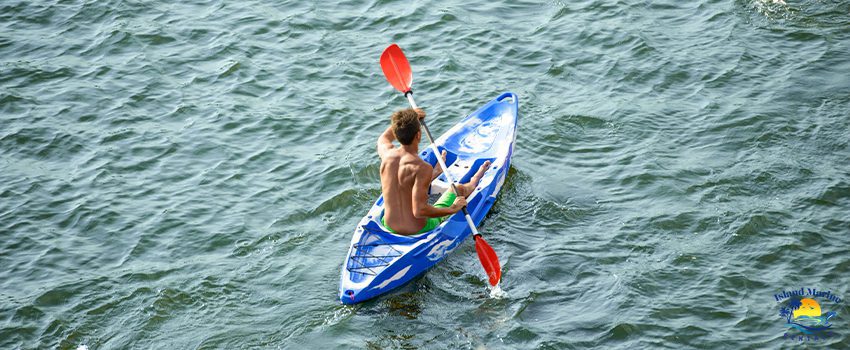You have now finally decided to give kayaking a try, and you’re excited to experience fresh blue waters and nature on one. But, do you know what type of kayak suits you better? You’ve probably heard or seen the sit-in type but might not know there’s another one: a sit-on-top kayak.
A kayak is a narrow boat popular for its distinct pointed edges tapering on both sides. Unlike usual boats, kayaks are lightweight and propelled by double-bladed paddles instead of oars or motors.
Kayaks can be hard-shelled or inflatable and can be categorized into two different designs- sit-on-top kayak (SOT) and sit-in kayak (SIK). Each kayak design is crafted for various uses and purposes.
What Is a Sit-on-Top Kayak?
Compared to a sit-in kayak, a sit-on-top kayak has an open cockpit design for easier outfitting. Its main parts include:
- The deck, which is the top of the kayak
- The hull or the bottom of the kayak
- The bow or the edge of the kayak pointing to the front
- The stern, which is the rear end of the kayak
Its distinct cockpit makes it popular among novice paddlers and surfers who prefer to enter and exit easily. Paddlers with large physiques can move comfortably in this type of design and not feel confined.
Now that you have the answer to “what is a sit-on-top kayak?” the next step in your kayaking journey is if you should give it a try or opt for another type. To help you with that, here are some pros and cons of a sit-on-top kayak.
The Pros of Riding a Sit-on-Top Kayak
1. Easy Access
A sit-on-top kayak enables you to fully enjoy the thrills of the water without worrying about drowning. Its open cockpit is one of its greatest assets and allows you to enter and exit conveniently.
The open cockpit also staves off claustrophobia. If you are just a beginner, you might want to try riding a sit-on-top kayak where it’s easier for you to re-enter in case it capsizes.
2. Stable and Resistant To Small Changes in Water Current
If you want to practice paddling, riding a sit-on-top kayak may be a great way to improve. Because it has a higher center of gravity, this type of kayak maintains stability and remains upright when moving on calm seas.
This stability is due to the kayak’s wider beam or the width at its widest point. If you are new to the world of kayaking and are still untrained at stabilizing it, try a sit-on-top kayak out and see if it’s the right one for you.
3. Unsinkable
Sit-on-top kayaks are crafted using molded plastic, which makes them tough and able to endure strong waves. Sinking is also impossible since a sit-on-top kayak features sealed air space between the cockpit and the bottom of the kayak.
With its inherent buoyancy, you will easily stay afloat even when kayaking in tandem.
4. Accessible Drain Plugs
Having to deal with water bilges is strenuous work. Fortunately, a sit-on-top kayak features draining outlets that remove collected water.
The self-draining scupper holes positioned on the rear side of the kayak near ground level let the water flow out the kayak instead of inside its sidewalls. You won’t have to deal with wet shoes.
5. Wide Variety
Whether you intend to go surfing, snorkeling, fishing, or just mere paddling and voyaging the relaxing blue waters, there are varieties of kayaks on the market perfect for your specific need. Usually, sit-on-top kayaks are more budget-friendly compared to other models.
If you are a fishing enthusiast and want to step up your fishing game, go kayak fishing on a sit-on-top kayak where you can freely move in its open cockpit.
The Cons of Riding a Sit-on-Top Kayak
1. Not Suitable for Rough Seas
Although it can still move across rough seas, its high center of gravity can cause it to wobble or tip when faced with strong waves. Regardless of the pros and cons of sit-on-top kayaks, you should avoid paddling through breaking waves, especially those reaching beyond three feet high.
In some instances where you must pass through strong waves, allow the kayak to move with the wave to keep your body stable and your hips loose.
2. Moves Slower
A kayak with a wider beam has many advantages and disadvantages. Sit-on-top kayaks are bigger and move slower, requiring more paddling to advance.
It is also difficult to maneuver kayaks with wider beams; leaning to the side is more unstable. You may need to keep your upper body still and head straight when tilting the kayak sideways.
3. Exposure to Natural Elements
A sit-on-top kayak has a more open design that exposes you to rain, cold winds, and even waves sloshing through the pointed front of the kayak. This may not be a problem if you are kayaking for recreational purposes. But if you intend to stay dry, make sure to wear water-repellent clothes.
The kayak’s open design will not also protect you from heat waves, so be careful when staying under the sun to avoid hyperthermia.
Explore the Kayaking World With Us
Kayaking is an enjoyable experience that can bring you closer to nature. And it can get better.
Here at Island Marine Rentals, even if you do not have your own equipment, we can help you tick off your outdoor bucket list by bringing you kayak, paddleboard, and boat rentals in Madeira Beach, FL.
If kayaking is next on your list, contact us right away, and we will offer you the best packages that will suit your needs. We are always thrilled that our products are there to help make your vacation trip a fun one.


